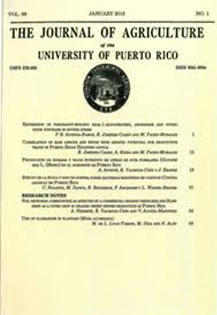Abstract
Pineapple heart rot disease (PHRD) caused by Phytophthora spp. is one of the most important diseases of pineapple. This disease is characterized by soft rot and water-soaked lesions. In severe cases plant mortality is 100%. During a one-year survey, conducted from March 2018 to March 2019, a total of 29 pineapple hectares were evaluated from five commercial pineapple fields located in the Puerto Rican municipalities of Guánica, Lajas, Manatí and Santa Isabel, and at the Agricultural Experiment Substation of the University of Puerto Rico in Isabela. Symptoms of PHRD were observed in all fields evaluated, except at the Agricultural Experiment Substation in Isabela. Diseased plant tissue was surface disinfected and plated on PARPH-V8 selective media for Phytophthora spp. Aerial photography using a DJI Phantom 3 drone was used to corroborate PHRD incidence in the field. Approximately eight hectares were infected by P. nicotianae with an average of PHRD disease incidence of 28.82%. The highest percentage of PHRD incidence was observed in fields located at Guánica, Lajas and Manatí with 40%, 40% and 30%, respectively. Eleven isolates of Phytophthora nicotianae were collected from pineapple fields in Guánica, Lajas, Manatí and Santa Isabel and identified using morphology and phylogeny of sequences of the mitochondrial cytochrome oxidase subunit I region (COI). The estimation of the incidence of P. nicotianae as the causal agent of PHRD is important as a first step in developing specific control measures in the pineapple fields of Puerto Rico.

